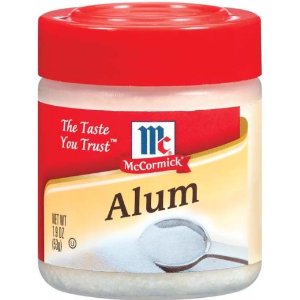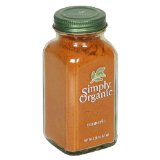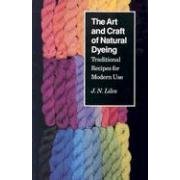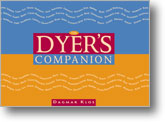I found that fabrics dyed with blueberries faded the least. Can you please give me a scientific explanation why this happened?
Name: Stacey
—ADVERTISEMENTS—
Alum can be used safely as a mordant only if there is no risk that anyone will attempt to eat it.

Not approved by the FDA for use in food; the fatal dose is one ounce for an adult (less than one small jar), and much less for a small child.
McCormick Alum Powder
Turmeric works well as a natural dye, though it fades quickly in the light and cannot be expected to last.

Simply Organic Ground Turmeric Root
A good book is important for learning to use natural dyes.

The Art and Craft
of Natural Dyeing:
Traditional Recipes for Modern Use
The Dyer's Companion contains clear recipes for mordants and dyeing.

The Dyer's Companion (The Companion Series)
by Dagmar Klos
Natural Dye COLORS Collection
Natural Dye KitThis comprehensive natural dyes kit contains Cochineal extract, Quebracho red, Logwood grey, Fustic, Indigo, Alum (Aluminum Acetate), Alum (Aluminum Sulfate), Cream of Tartar, Madder extract, Logwood purple, Cutch, Soda Ash, Iron, Scour (Washing agent for cellulose), Reducing agent for indigo (thiourea dioxide), Hide glue, pH strips, Mask and Gloves, and Instruction Book.
Buy fromParadise Fibers
Country or region: USA
Message: Hi. I'm in 8th grade and I am working on a science project testing the fading of different plant based dyed fabric when washed. I found that fabrics dyed with blueberries faded the least. Can you please give me a scientific explanation why this happened? Also, fabrics dyed with gold beets based dye faded a lot more. Why is this? Please note that I was dying 95% cotton 5% spandex material. Also I did not use any mordants or fixatives to help hold the dye to the fabric. Thanks
What you have there, unfortunately, is not "dyed" fabric - it's "stained" fabric. You did not use any good dyes—there are other foods that will make much better dyes, especially if mordanted properly—and you didn't use any mordant that could help the better natural dyes perform well as dyes. I am sorry that you did not contact me (or read the 'schoolwork' section of my blog) before doing your experiment, for assistance in choosing a better question to test. You can use the results of the experiments you've done for your science project, but it might be better to write it up from a different perspective than you planned.
For any substance to be a dye, two things are required:
- a good color; and
- an affinity for the fiber, so that the dye does not easily wash off.
Neither beets nor blueberries qualify as a dye under point 2. It's not enough for a substance to have a color; if it does not attach well to the fiber you're dyeing, it is not a dye.
Why did the stain from blueberries last longer than the stain from beets? In real life, it hardly matters, since it will still last almost no time at all! The bright blue color disappears almost immediately, replaced by a duller color, as the result of interactions with detergent or even simply the oxygen in air. Washing in sufficiently hot water, perhaps with the aid of an oxygen-containing laundry stain remover such as OxyBoost, will remove almost all that is left of the blueberries stain.
Blueberries are colored with natural anthocyanins (be sure to look up the chemical formula), which eventually wash out of clothing, and which change quickly from a lovely blue to a dull ugly color as the anthocyanin chemicals degrade. It appears that golden beets are colored with another natural chemical, betaxanthin (again, look up the chemical formula), but, as you have seen, it has no real affinity for unmordanted fabric, just like the betacyanins that color red beets.
Blueberries do have a slight affinity for the cotton fiber, but not a great one; this explains why they have formed more of a stain, although it's temporary, like the beets. Beets do not contain any usable textile dye at all, because their coloring truly does not have any affinity to the cotton fiber, not even enough to make much of a stain, as you saw.
The reason why boiling water is so good at removing blueberry stains, as well as any unattached dye of any sort, is that it significantly reduces the property called substantivity. Substantivity is the tendency of almost any large molecule to loosely associate with the textile fiber in question, such as cotton. Your results indicate that the pigment (not really a dye!) in blueberries has a greater substantivity toward cotton than the pigment in golden beets.
It is well known that neither blueberries nor beets make good dyes. There's quite a bit of information on this site available about this. Please read the following pages on my web site:
"Beets as a natural dye" (in the Dye Forum)
"Problems in Dyeing with Beets" (in the November 8, 2004 entry in this blog)
"I love the beet juice that comes from cooking beets, is there a way I can use this to dye a white cotton and have it stay?" (in the July 9, 2006 entry in this blog)
"Substitutes for Alum as a Mordant for Baby Clothes" (in the April 27, 2010 entry to this blog)
"My daughter’s 7th grade project is to make dyes from edible materials" (from the January 22, 2009 entry in this blog)
"Is there a natural way to set the dye? I know that salt or vinegar don't work...." (in the August 14, 2005 entry in this blog)
(Note that this last entry mentions post-mordanting, in which natural dyes can sometimes be saved by adding mordanting after the dyeing process, rather than before.)
"Dyeing for a Science Project" (in the October 19, 2004 entry in ths blog)
which includes the statement "There is no point at all in tie-dyeing a sheet with blueberries or coffee unless you are going to preserve it, unwashed, as an art project. "
"How Can I Dye with Foods such as Blueberries?" (in the December 10, 2010 entry in this blog), which mentions,
"Blueberries are colored with natural anthocyanins, while spinach is colored with chlorophyll. These colors are beautiful in the fresh food, but they turn dull when applied to textiles. For a thousand years, people have preferred to use indigo to dye clothing a blue color, because indigo is a much longer-lasting, brighter blue dye. To dye clothing or tapestries a green color, it is traditional to use indigo plus a natural yellow dye to make the green, because the green of chlorophyll that is found in the leaves of plants does not stay green, but instead turns brown."
Also see my explanation of exactly how to convert the colors of your test materials to numbers that can be graphed, using a scanner plus a photo program such as Adobe Photoshop Elements (which is far less expensive than the full Adobe Photoshop program, and also far less expensive than a proper scanning spectrophotometer, which is way beyond the reach of most middle and high school science programs). See:
"Graphing Dye Experiment Results for a Science Fair Project" (in the January 26, 2008 entry in this blog).
Other science fair project questions and answers can be found in the "Schoolwork" section of my blog; click on the "Read More" under each title to see the complete article.
Reading a good book about natural dyes will be very helpful to you in the future before choosing natural dyes to try. I strongly recommend J. N. Liles' book, "The Art and Craft of Natural Dyeing", which contains a vast number of reliable recipes for dyeing not just wool, but also cotton, linen, and silk, using many different natural substances. Check your local public library to see whether they have it, or another good book about natural dyes and dyeing, in their collection.
You will need to cite this communication from me, among your references; here is one way to format this citation:
Burch, Paula E. "I Found That Fabrics Dyed with Blueberries Faded the Least. Can You Please Give Me a Scientific Explanation Why This Happened?" Paula Burch's All About Hand Dyeing. Paula Burch, 30 Nov. 2011. Web. 30 Nov. 2011. <http://www.pburch.net/dyeing/dyeblog/C22699859/E20111130074509/index.html>.
Good luck to you in writing up your project.
(Please help support this web site. Thank you.)
(Please help support this web site. Thank you.)
Posted: Wednesday - November 30, 2011 at 07:45 AM
Follow this blog on twitter here.
Quick Links
- All About Dyes & Dyeing Top -
- Top of this blog -
- FAQ -
- The Dye Forum -
- How to Tie Dye - How to Batik -
- Books - Toys - Plants -
- Top of this blog -
- FAQ -
- The Dye Forum -
- How to Tie Dye - How to Batik -
- Books - Toys - Plants -
More in this category:
- -
Statistics
Total entries in this blog:
Total entries in this category:
Published On: Aug 29, 2012 02:49 PM
Total entries in this category:
Published On: Aug 29, 2012 02:49 PM
